The dental industry has come a long way in the past few decades. Advancements in technology have allowed for new and innovative treatments to be developed and have helped to improve the overall quality of dental care.
These developments also played a role in the increasing demand for dental professionals. More professionals are entering the industry since technology has made work easier. We will explore how technology helped shape the dental industry and how it has impacted the lives of those who work in it.
Increasing use of dental lasers
One of the most notable ways that technology has helped shape the dental industry is through the increasing use of dental lasers. Lasers offer several benefits over traditional treatments, including:
- Reduced pain and discomfort – Lasers are often much less painful than traditional treatments, making them a more appealing option for patients.
- More precise – Lasers allow for much more precise and accurate treatment, which can improve the overall effectiveness of dental procedures.
- Faster healing – Laser treatments also heal faster than traditional methods, helping patients get back on their feet more quickly.
Overall, dental lasers have been a major driver of growth in the dental industry in recent years.
Digital X-rays
One of the most important benefits of digital x-rays is safer for both the patient and the dentist. With traditional x-rays, patients had to sit still for long periods while a large amount of radiation was administered. This was not only uncomfortable but also potentially harmful. Digital x-rays use far less radiation and can be acquired much more quickly.
Another key benefit of digital x-rays is that they allow dentists to get a more detailed and accurate view of the teeth and oral cavity. This allows them to diagnose problems better, plan treatments, and monitor patients’ progress over time. With this increased accuracy and precision, treatment outcomes are improved.
There are many other ways technology has helped the dental industry, from improved tools and equipment to new treatment methods. Whether a patient or a dentist, you should understand how these advancements can benefit your oral health.
Development of dental implants
Dental implants are one of the most significant advances in dentistry in the past century. They are used to replace missing teeth and can be used in either the upper or lower jaw. Dental implants are made of titanium, which is biocompatible, which is compatible with the human body.
Technology and materials have made dental implants more effective and easier to use. Today, there are many different dental implants available, including mini dental implants, which are smaller and can be used when the jaw is not big enough to support a regular dental implant.
Technology also allowed dental professionals to offer better tooth replacement services. The dental implants they use look like actual teeth, giving patients the confidence they need to socialize.
The main advantage of dental implants is that they look and feel like natural teeth. They are also very strong and durable and can last a lifetime with proper care. In addition, dental implants can help preserve the jawbone and prevent it from deteriorating.

Use of digital dentistry
Digital dentistry has revolutionized the dental industry with its use of technology. Some of the benefits of digital dentistry include:
- Increased accuracy – With digital dentistry, practitioners can achieve increased accuracy when performing dental procedures.
- Increased efficiency – Digital dentistry has also helped increase the efficiency of dental procedures.
- Improved patient care – The use of technology in the dental industry has improved patient care.
Use of intraoral scanners
Intraoral scanners are another area where digital dentistry has had a major impact. Intraoral scanners are used to create 3D images of the mouth and teeth, which can be used for various purposes, such as diagnosing problems, planning treatments, and monitoring the progress of patients.
The benefits of intraoral scanners include:
- Improved accuracy and precision: Intraoral scanners use advanced imaging technology to create highly detailed images of the teeth and oral cavity. This allows dentists to more accurately diagnose problems, plan treatments, and track patient progress over time.
- Reduced need for invasive procedures: Intraoral scanners can also help reduce the need for invasive treatment procedures, such as dental surgeries. This is because intraoral scanners can be used to identify problems early on and plan more conservative treatment methods.
- Increased patient satisfaction: Patients who undergo dental treatments using intraoral scanners tend to have higher satisfaction levels, as they experience less pain and discomfort than traditional methods. In addition, the use of intraoral scanners can also help save time, as treatments can be completed in a single visit.
Technology has had a significant impact on the dental industry, with advancements in tools and equipment, new treatment methods, and the use of digital dentistry. These advances have helped improve accuracy and precision, increase efficiency, and provide better patient care. With the continued use of technology in the dental industry, patients can expect even more improvements in the quality of care.


